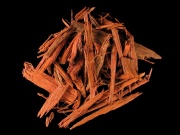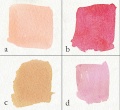Difference between revisions of "Brazilwood dye"
m (Text replace - "== Authority ==" to "== Sources Checked for Data in Record ==") |
|||
| Line 12: | Line 12: | ||
madera de brasil (Esp.); brasileto (Esp.); bois de Bresil (Fr.); Rotholz (Deut.); rosso Brasile (It.); verzino (It.); Braziliehout (Ned.); suo (Jap.); suwo (Jap.); corante de pau brasil (Port.); brazil-wood dye; Brazil wood dye; permambuco extract; brasilein; brazilein; brazilin; brasilin; brazil wood; red lake; rose pink; fermambuco; red bud; soluble redwood; rose pink; hypernic wood; peachwood; sappanwood | madera de brasil (Esp.); brasileto (Esp.); bois de Bresil (Fr.); Rotholz (Deut.); rosso Brasile (It.); verzino (It.); Braziliehout (Ned.); suo (Jap.); suwo (Jap.); corante de pau brasil (Port.); brazil-wood dye; Brazil wood dye; permambuco extract; brasilein; brazilein; brazilin; brasilin; brazil wood; red lake; rose pink; fermambuco; red bud; soluble redwood; rose pink; hypernic wood; peachwood; sappanwood | ||
| − | == | + | == Physical and Chemical Properties == |
Brasilin is soluble in water, acids (decomposes) and weak alkalis. | Brasilin is soluble in water, acids (decomposes) and weak alkalis. | ||
Revision as of 09:25, 28 October 2020
Description
A natural red dye produced from the hot water extraction of any of several tropical trees of the senna genus, Caesalpinia, such as C. brasiliensis (from Brazil), C. crista (from Pernambuco), C. echinata (peachwood from Nicaraugua), or C. sappan (sappanwood from East Indies and Asia). Brazilwood was used to dye textiles as early as the 12th century in Europe. Its principal colorant is Brasilin, a hydroxyanthraquinone, that gives a deep red to brownish color when it is oxidized to form brasilein. Brazilwood produces purple shades with a chrome mordant and crimson shades with alum. When mordanted on chalk, brazilwood produces lakes ranging in colors from lavender to cherry to deep red. It was a cheaper red lake pigment than carmine. Brazilwood dye has been used for textile dyes, inks, paints, varnish tints, and wood stains. The color is not lightfast and fades when heated.
Synonyms and Related Terms
madera de brasil (Esp.); brasileto (Esp.); bois de Bresil (Fr.); Rotholz (Deut.); rosso Brasile (It.); verzino (It.); Braziliehout (Ned.); suo (Jap.); suwo (Jap.); corante de pau brasil (Port.); brazil-wood dye; Brazil wood dye; permambuco extract; brasilein; brazilein; brazilin; brasilin; brazil wood; red lake; rose pink; fermambuco; red bud; soluble redwood; rose pink; hypernic wood; peachwood; sappanwood
Physical and Chemical Properties
Brasilin is soluble in water, acids (decomposes) and weak alkalis.
Brasilin is insoluble in alcohols.
ISO R 105 Lightfastness Classification = 3 (mordanted with aluminum acetate)
Additional Images
Sources Checked for Data in Record
- Palmy Weigle, Ancient Dyes for Modern Weavers, Watson-Guptill Publications, New York, 1974
- R. Newman, E. Farrell, 'House Paint Pigments', Paint in America , R. Moss ed., Preservation Press, New York City, 1994
- R.Feller, M.Curran, C.Bailie, 'Identification of Traditional Organic Colorants Employed in Japanese Prints and Determination of their Rates of Fading', Japanese Woodblock Prints, Allen Memorial Art Museum, Oberlin College, Oberlin, 1984
- F. Crace-Calvert, Dyeing and Calico Printing, Palmer & Howe, London, 1876
- The Dictionary of Art, Grove's Dictionaries Inc., New York, 1996 Comment: "Pigments"
- Judith Hofenk-de Graaff, Natural Dyestuffs: Origin, Chemical Constitution, Identification, Central Research Laboratory for Objects of Art and Science, Amsterdam, 1969
- J. Thornton, 'The Use of Dyes and Colored Varnishes in Wood Polychromy', Painted Wood: History and Conservation, The Getty Conservation Insitute, Los Angeles, 1998
- E.J.LaBarre, Dictionary and Encyclopedia of Paper and Paper-making, Swets & Zeitlinger, Amsterdam, 1969
- R. J. Gettens, G.L. Stout, Painting Materials, A Short Encyclopaedia, Dover Publications, New York, 1966 Comment: p. 99
- G.S.Brady, Materials Handbook, McGraw-Hill Book Co., New York, 1971 Comment: p. 117
- Ralph Mayer, A Dictionary of Art Terms and Techniques, Harper and Row Publishers, New York, 1969 (also 1945 printing)



